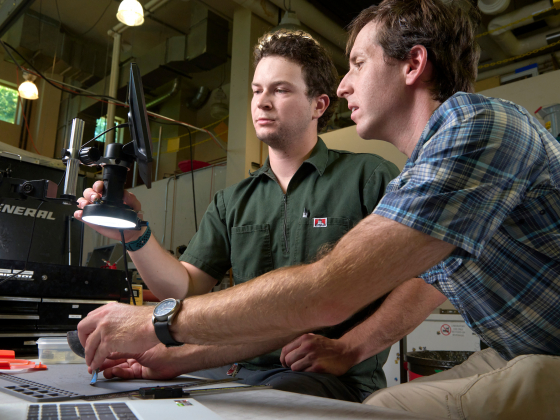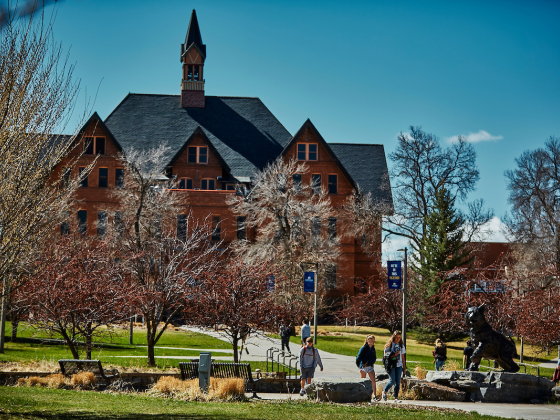BOZEMAN — Two graduate students at Montana State University recently gave presentations at an international conference on a unique carbon fiber composite that could one day reduce manufacturing and operational costs of airplanes, helicopters and other flying forms of transportation by making them significantly lighter without compromising their strength.

Yoni Shchemelinin, a mechanical engineering doctoral student, and Cooper Williams, a mechanical engineering master’s student, both in the Department of Mechanical and Industrial Engineering in MSU’s Norm Asbjornson College of Engineering, gave their presentations in May on stretch broken carbon fiber, or SBCF, at the Vertical Flight Society’s Annual Forum and Technology Display held in Virginia Beach, Virginia.
Shchemelinin and Williams each work with SBCF, a composite that’s as strong as steel but six times lighter. The work at MSU is supported by $35 million in contracts from the U.S. Army and other sources. The SBCF research teamincludes 15 faculty and staff, 10 graduate students and three undergraduates. The research they’re undertaking has been ongoing since 2018.
“I commend Yoni and Cooper for their outstanding presentations at the Vertical Flight Society conference,” said Dilpreet Bajwa, head of the Department of Mechanical and Industrial Engineering. “They put significant thought and effort into their work, communicating complex ideas to a diverse audience in aerospace research. The presentations demonstrated the superior formability of stretch broken carbon fibers for primary aircraft structures.”
“Formability” in this context is the ability of composites to be shaped into three-dimensional parts without developing defects such as wrinkles, cracks or other imperfections during the manufacturing process.
Shchemelinin earned a bachelor’s degree in mechanical engineering from the University of California, Merced, and worked in the private sector in Bozeman prior to pursuing a Ph.D. at MSU. He said the current challenge of working with SBCF’s unbroken counterpart – continuous carbon fiber – is its limited formability.
“That’s really where a lot of the cost factor comes in,” he said. “The raw materials themselves are not that expensive. But by the time you make something out of it that you actually want to use, the workmanship costs a lot – up to a hundred times the cost of the materials.”
Shchemelinin likened continuous carbon fiber to a multiple strands of spaghetti aligned in a bundle.
“When you try to shape it into a part you’d like to use, you start feeling a lot of resistance. It’s brittle,” he said. “However, you take that same strand of spaghetti and stretch it until it breaks at natural weak points, you’ll have individual strong strands that make it a lot easier to make into various shapes.”
Researchers are working to lower the cost by decreasing the labor required to form composites into usable shapes through the use of SBCF.
“Stretch broken carbon fiber solves two important problems for aircraft and other structures made with advanced composite materials,” said Doug Cairns, the Lysle A. Wood Distinguished Professor in the Department of Mechanical and Industrial Engineering and director of MSU’s SBCF Team. “First, it decreases cost. Touch labor time can be decreased by eight times as demonstrated by the MSU team, which has made the most formable SBCF to date. Second, hybrid metal and composite structures can be avoided.”
“Touch labor” refers to the hands-on, manual work required to fabricate parts.
Cooper, who earned a bachelor’s degree in mechanical engineering from Northern Arizona University, said the time required to form stretch broken carbon fiber is lessening due to the “enhanced formability” of the SBCF itself.
“You can lower some of those costs by lowering the time spent making the composites and [touch labor],” he said. “The idea is that the enhanced formability lowers the time involved, because there are fewer defects in the cured part [compared to CCF].”
Cooper reiterated that this technology holds promise for the aviation field in particular.
“I think there’s potential for big applications for SBCF in both the commercial and military aviation fields,” he said. “I think the main goal is a lot of aircraft structures would be replaced with stretch broken carbon fiber. I think the big game changer would be to replace the wing substructure of aircrafts or the fuselage with SBCF.”
In addition to providing strength equivalent to steel at a fraction of the weight, thus reducing manufacturing and fuel costs, the material can reduce corrosion at points where metal meets composite materials that are currently in use.
“That is cause for service requiring increased maintenance of the vehicles,” Cooper said. “So, the hope is that you’ll see lower costs in manufacturing and lower costs in operating them, so you are making the consumers’ dollars more efficient. And, also on the military side, you make the taxpayers’ dollars more efficient.”.




